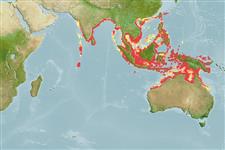>
Clupeiformes (Herrings) >
Engraulidae (Anchovies) > Engraulinae
Etymology: Stolephorus: Greek, stole, -es = garment + Greek, pherein = to carry (Ref. 45335).
Eponymy: Edgar Ravenswood Waite (1866–1928) was an English-born Australian zoologist and ichthyologist. [...] (Ref. 128868), visit book page.
More on authors: Jordan & Seale.
Issue
Junior synonym Stolephorus bataviensis Hardenberg, 1933 is considered valid in CofF ver. 06 June 2023 following Hata et al., 2019 (Ref. 128121:11).
Environment: milieu / climate zone / εύρος βάθους / distribution range
Οικολογία
Θαλασσινό(ά); Γλυκού νερού; Υφάλμυρο pelagic-neritic; ωκεανόδρομο(ς) (Ref. 51243); εύρος βάθους 0 - 50 m (Ref. 189). Tropical; 25°N - 21°S, 71°E - 151°E (Ref. 189)
Indo-Pacific: western Indian Ocean (from Cochin and southern tip of India to Myanmar) and western Pacific (Thailand, Java Sea, the Philippines, probably Irian Jaya, if not also Papua New Guinea, south to Queensland; perhaps even more widespread). Its geographical overlap and similarity to S. insularis cast doubts on the several Indian studies of `insularis'. One of the commonest species of genus Stolephorus.
Length at first maturity / Μέγεθος / Βάρος / Age
Γεννητική Ωρίμανση: Lm 8.4 range ? - ? cm
Max length : 9.4 cm SL αρσενικό/απροσδιόριστο; (Ref. 189); common length : 6.5 cm SL αρσενικό/απροσδιόριστο; (Ref. 189)
Ραχιαίες άκανθες (συνολικά) : 0; Εδρικές άκανθες: 0; Μαλακές εδρικές ακτίνες: 18 - 20. Belly with 5 to 7 small needle-like pre-pelvic scutes. Maxilla tip pointed, reaching to hind border of pre-operculum, the latter almost always convex, rounded. Pelvic fin tips only rarely reaching to below dorsal fin origin. Numerous black spots below level of eye and on tip of lower jaw, by which it is generally distinguished from other species; a dark patch behind occiput.
Body shape (shape guide): elongated; Cross section: compressed.
A pelagic, schooling species found in coastal waters. Caught mainly with seines (beach and purse), traps often using light, incidentally with bottom trawls. Marketed fresh, dried, dried-salted or made into fish meal, fish sauce fish balls and used as bait (Ref. 9822).
Wongratana, T., T.A. Munroe and M. Nizinski, 1999. Order Clupeiformes. Engraulidae. Anchovies. p. 1698-1753. In K.E. Carpenter and V.H. Niem (eds.) FAO species identification guide for fishery purposes. The living marine resources of the WCP. Vol. 3. Batoid fishes, chimaeras and bony fishes part 1 (Elopidae to Linophrynidae). FAO, Rome. (Ref. 9822)
IUCN Red List Status (Ref. 130435: Version 2025-1)
Threat to humans
Harmless
Human uses
αλιεία: Εμπορικό(ά)
Εργαλεία
Special reports
Download XML
Διαδικτυακές πηγές
Estimates based on models
Preferred temperature (Αναφ.
123201): 26.7 - 29.1, mean 28.4 °C (based on 1120 cells).
Phylogenetic diversity index (Αναφ.
82804): PD
50 = 0.5000 [Uniqueness, from 0.5 = low to 2.0 = high].
Bayesian length-weight: a=0.00513 (0.00280 - 0.00939), b=3.07 (2.92 - 3.22), in cm total length, based on LWR estimates for this species & Genus-body shape (Ref.
93245).
Τροφικό Επίπεδο (Αναφ.
69278): 3.3 ±0.4 se; based on size and trophs of closest relatives
Ελαστικότητα (Αναφ.
120179): Μεσαίο(α), ελάχιστος χρόνος για διπλασιασμό πληθυσμού 1,4 - 4,4 έτη (K=0.16).
Fishing Vulnerability (Ref.
59153): Moderate vulnerability (42 of 100).
🛈
Nutrients (Ref.
124155): Calcium = 565 [193, 1,588] mg/100g; Iron = 2.77 [1.46, 4.87] mg/100g; Protein = 18.8 [17.0, 20.7] %; Omega3 = 0.296 [0.129, 0.704] g/100g; Selenium = 60.9 [23.8, 146.0] μg/100g; VitaminA = 26.9 [6.2, 109.4] μg/100g; Zinc = 3.05 [1.92, 4.83] mg/100g (wet weight); based on
nutrient studies.
